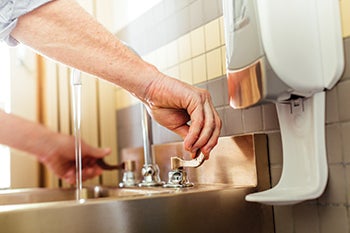Copper materials for health care interiors
 |
| PHOTO COURTESY OF CUVERRO/OLIN BRASS The germ-killing effects of copper are continuous, require no intervention from the health care team and work in conjunction with other hospital cleaning methods and hand-hygiene practices. |
An ancient technology is being deployed anew to prevent infections in health facilities. Early civilizations recognized that water stored in copper vessels remained fresh. Due to its intrinsic germ-killing properties, copper is now being used in the development of products and materials for health care interiors.
“This is 5,000-year-old technology that we’re rediscovering today, in the 21st century, and exploiting to our advantage,” says Michael Schmidt, professor and vice chairman of microbiology and immunology at the Medical University of South Carolina (MUSC), Charleston.
‘Second line of defense’
Microbes that have become resistant to disinfectants or antibiotics are defenseless against the effects of copper, which begins to destroy these organisms at a cellular level on contact, via multiple processes related to the material’s chemistry. “Any microbe they have tested, it works against,” says Schmidt. These include methicillin-resistant Staphylococcus aureus, vancomycin-resistant enterococci, Enterobacter aerogenes, Pseudomonas aeruginosa and Escherichia coli O157:H7. “And it works against viruses,” Schmidt adds. “It’s been demonstrated to knock out Norovirus.”
You may also like |
| Interior finishes for cleanability and germ resistance |
| Health care-associated infection resistant designs |
| Improving patient safety through design |
| |
In a published clinical trial conducted by MUSC, the Department of Veterans Affairs and Memorial Sloan Kettering Cancer Center, New York City, several products containing copper alloys were installed in proximity to hospitalized patients, on items such as the bed rail, IV pole and nurse call button. Says Schmidt, “We were able to show that the incidence of infection dropped by 58 percent” compared with that of infections contracted by patients treated in rooms without the copper alloys. “By virtue of the fact that we were able to cut the infection rate, all other things being equal, it effectively makes the argument that the environment … could be responsible for about half of the infections that patients get while hospitalized,” he says.
Because copper’s biocidal qualities are inherent to the material, the effects are continuous, require no intervention by caregivers or environmental services staff and work in conjunction with other hospital cleaning methods and hand-hygiene practices.
“It is a second line of defense, and one of the only things out there that works in between all of these episodic interventions that are going on,” says Adam Estelle, project engineer with the Copper Development Association (CDA), New York City, an industry group. If someone sneezes on a clean copper surface, “immediately it’s going to start dropping that bioburden,” Estelle says. “And that’s really, to me, the key value and the reason hospitals are looking at this. Because in spite of all these best efforts, we still have infections as an issue.”
In the past several years, the use of copper as a modern-day tool for fighting infection has progressed from theory to commercial adoption, through laboratory science, regulatory testing and clinical trials that have demonstrated “the real data-driven impact that can be observed from using this technology,” Estelle says. He notes that there is now a full range of products available that utilize copper, with a broad spectrum of colors and mechanical properties to meet the design standards of any facility.
Copper alloys
CuVerro, by Olin Brass, Louisville, Ky., is a class of solid-copper alloys registered by the Environmental Protection Agency (EPA) that can be used on high-touch surfaces in health care environments to kill 99.9 percent of infectious bacteria within two hours of contact when cleaned regularly. The company works with leading manufacturers that supply health facilities to develop products that incorporate CuVerro, says Anthony M. Kulik, director, CuVerro business, Olin Brass.
Among the products offered by CuVerro affiliates are sinks from Elkay Manufacturing Co., Oak Brook, Ill., and Just Manufacturing, Franklin Park, Ill.; Arrow Hart light switches and wall plates from Eaton’s Cooper Wiring Devices, Peachtree City, Ga.; CuSalus cabinet and architectural hardware from Colonial Bronze Co., Torrington, Conn.; and Healthy Hardware architectural door hardware from Trimco, Los Angeles.
CuVerro is available in a variety of copper alloys. Two of the most popular contain nickel, Kulik says. “Depending on the level of nickel you put into your alloy, you’re going to have slightly different metallic properties,” he explains. The alloy with less nickel has a slight rose color that visually communicates the copper composition. The alloy with more nickel looks like stainless steel, and can be used alongside other stainless products to blend into an existing aesthetic.
Two years ago, Pullman (Wash.) Regional Hospital received a $10,000 grant from the CDA to incorporate copper alloy materials in high-touch surfaces of the facility. The hospital installed new door handles, push buttons for automatic doors, faucet levers in public and patient bathrooms, bed rails, over-bed tabletops and IV poles. “We thought it could help behind the scenes, while we still clean as we always have,” says Ed Harrich, R.N., director of surgical services at Pullman. The grant was part of an effort at the hospital, which reports a below-average, health care-associated infection (HAI) rate of 1.6 percent, to bring its number of HAIs to zero.
Pullman Regional now has committed to replacing 1,200 cabinet pulls with those made from copper alloys, along with 146 faucet handles and 20 push-button door plates. Harrich says he’s excited by the number of companies coming on board with products that incorporate copper, as well as how much prices have dropped since the hospital began this endeavor. He says the organization originally paid $20 per cabinet pull, and five months later the cost was $6 each. As more health facilities can afford to implement copper initiatives, “I can see it having a huge impact,” says Harrich. “It’s good for hospitals and it’s good for society.”
Grinnell (Iowa) Regional Medical Center (GRMC) is conducting a clinical trial of CuVerro products at its facility. Shannon Hinsa-Leasure, associate professor of biology at Grinnell College, is leading the study, along with Schmidt, of MUSC. Since the trial began, the hospital has extended its use of the material beyond the hospital building. “We were so excited about how well CuVerro was reducing the bacteria load in our hospital trial, we added copper touch surfaces to our new community fitness center,” says Todd C. Linden, FACHE, president, GRMC. He reports that the hospital is the third customer, after the U.S. and Canadian Olympic training centers in Colorado Springs, Colo., and Calgary, Alberta, Canada, to utilize dumbbells and kettle bells with CuVerro touch surfaces manufactured by Black Iron Strength Inc., Vancouver, Wash.
Copper oxide
Cupron Inc., Richmond, Va., has developed a proprietary technology to embed cuprous (copper) oxide into various fibers and substrates to imbue them with copper’s biocidal properties. “One of the reasons it’s so important to have this product incorporated into medical facilities is really as an added layer of protection,” says microbiologist and epidemiologist Alastair Monk, director of clinical and scientific affairs, Cupron. “Hand-washing compliance is very important, but it can only take you so far. There’s still the risk of bacteria growing on surfaces, especially pathogenic bacteria.”
EOS Surfaces, Norfolk, Va., invented a way to suspend Cupron throughout EOS’s own proprietary polymer surface material to create Cupron Enhanced EOS Surfaces, or EOScu. EOScu is the only synthetic hard surface that is registered by the EPA, as the CuVerro class of copper alloys is, to kill greater than 99.9 percent of gram-negative and gram-positive bacteria within two hours of exposure; to continuously reduce bacterial contamination, achieving a 99.9 percent reduction within two hours of exposure; to continue to kill 99 percent of bacteria even after repeated contamination; and to inhibit the buildup and growth of bacteria within two hours between routine cleaning and sanitizing, the company states.
Ken Trinder, CEO, EOS, says the goal of the EOScu project was to develop a product that could help fight against HAIs by providing the same active and continuous killing as other forms of copper in a functional manner in health care environments, while allowing the surface to maintain its original aesthetic. The material is available as a slab-based product for fabrication into horizontal and vertical surfaces like countertops and walls, and as an injection-molded product for items like patient bed rails and over-bed tables.
The EOS hard surfaces, along with Cupron’s linens, are undergoing a clinical trial that originated in the new 129-bed East Tower of Sentara Healthcare’s Sentara Leigh Hospital, Norfolk. To create a larger data pool, the clinical trial has been expanded to include additional Sentara Healthcare facilities.
Sentara Healthcare “is interested in anything that may make our patients safer,” says internist and board-certified infectious disease specialist Scott A. Miller, M.D., FACP, vice president of medical affairs, Sentara Leigh Hospital. “The organization is trying to improve care.”
‘Always working’
Schmidt says studies have shown that microbes repopulate vulnerable surfaces in health care environments within six hours of the surfaces being properly cleaned. “There’s no way anyone can afford to clean the room as often as it needs to be cleaned,” he says. “So, by putting in something like copper, that’s always there, always working, and doesn’t require any human intervention — you can well imagine how it’s a supplement to good hygiene practices.
“And that’s effectively what you want,” he adds. “You want something to help the health care team.”
Links to vendor resources
Below are links to the vendors who were covered in this article, in order of appearance:
Olin Brass: www.cuverro.com
Elkay Manufacturing Co.: www.elkay.com
Eaton’s Cooper Wiring Devices: www.cooperindustries.com
Colonial Bronze Co.: www.colonialbronze.com
Trimco: www.trimcohardware.com
Black Iron Strength Inc.: www.blackironstrength.com
Cupron Inc.: www.cupron.com
EOS Surfaces: www.eos-surfaces.com




